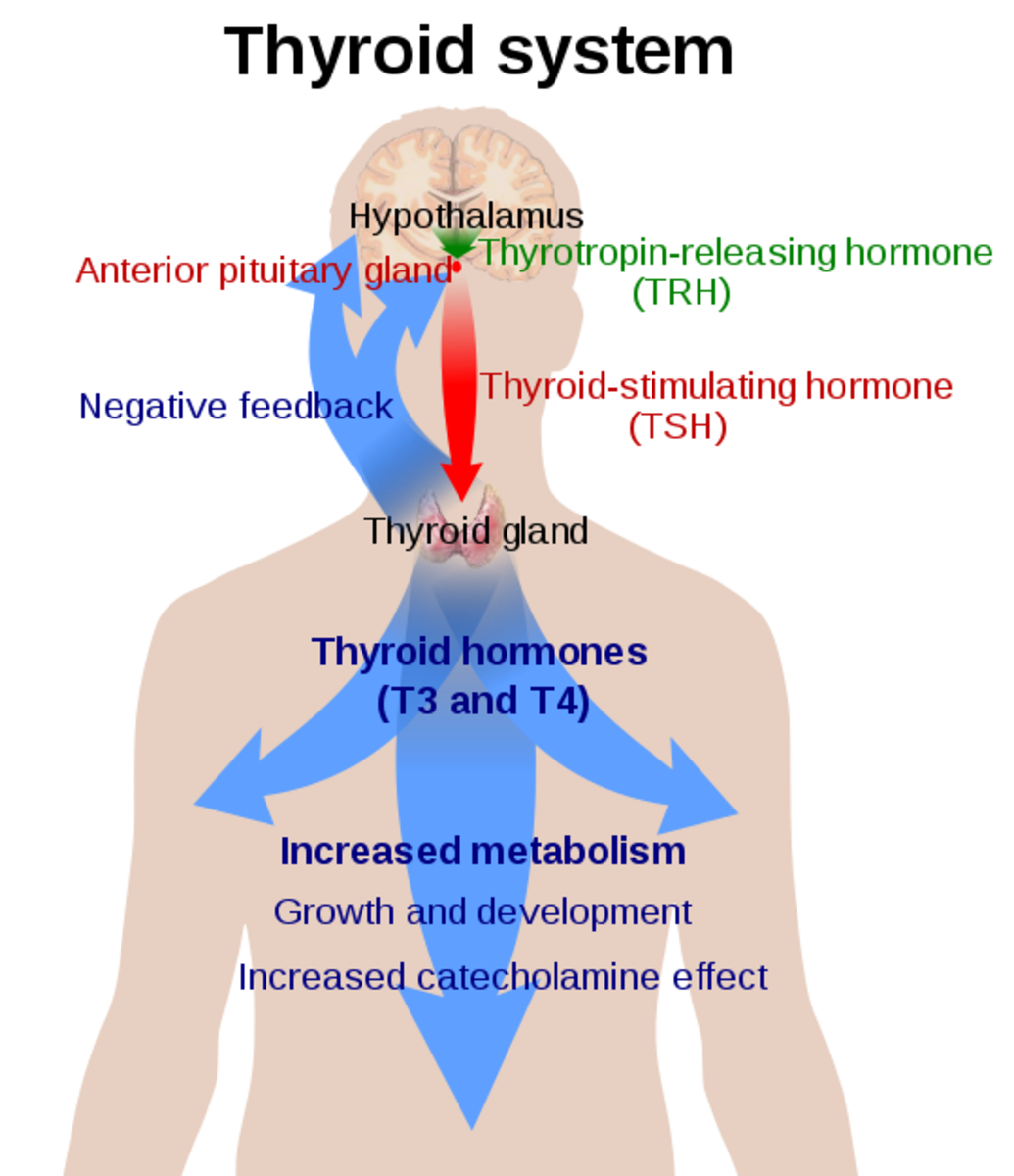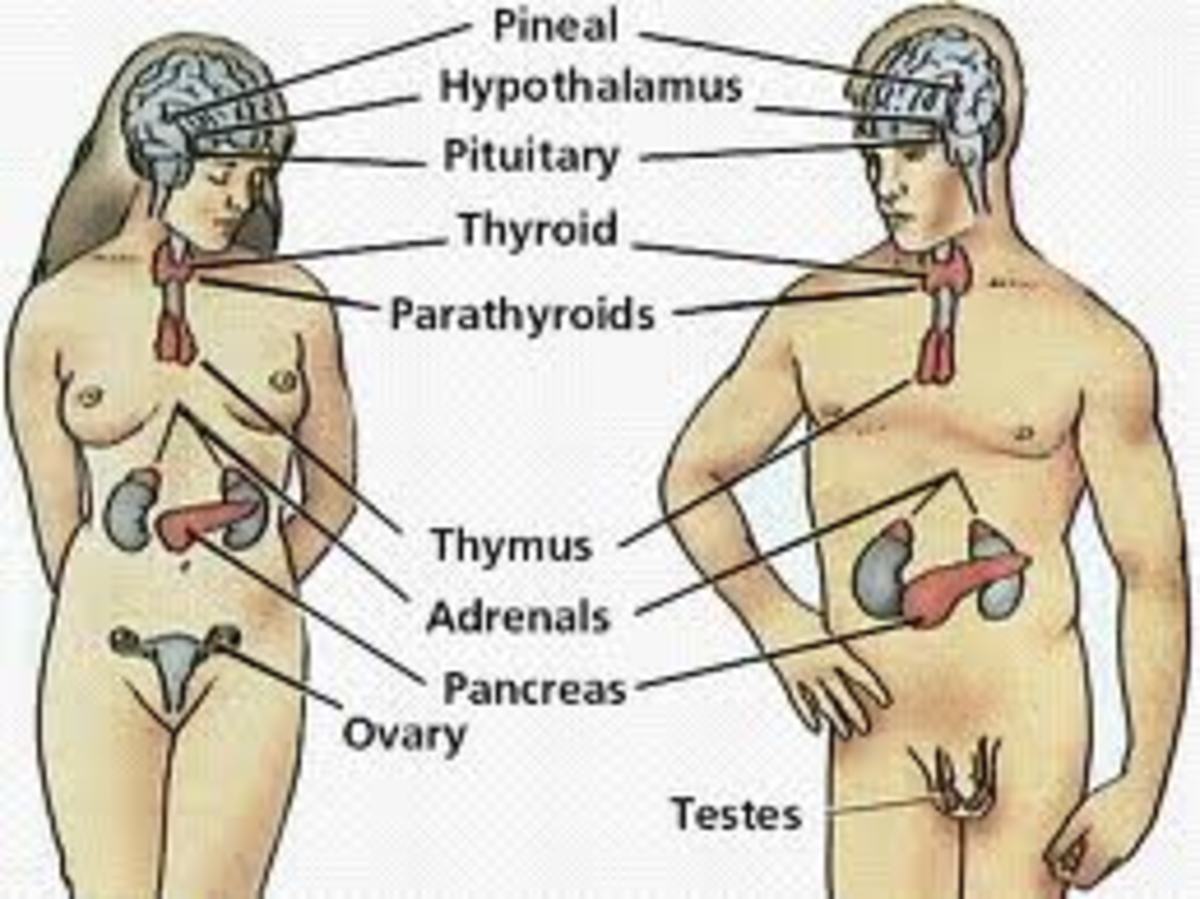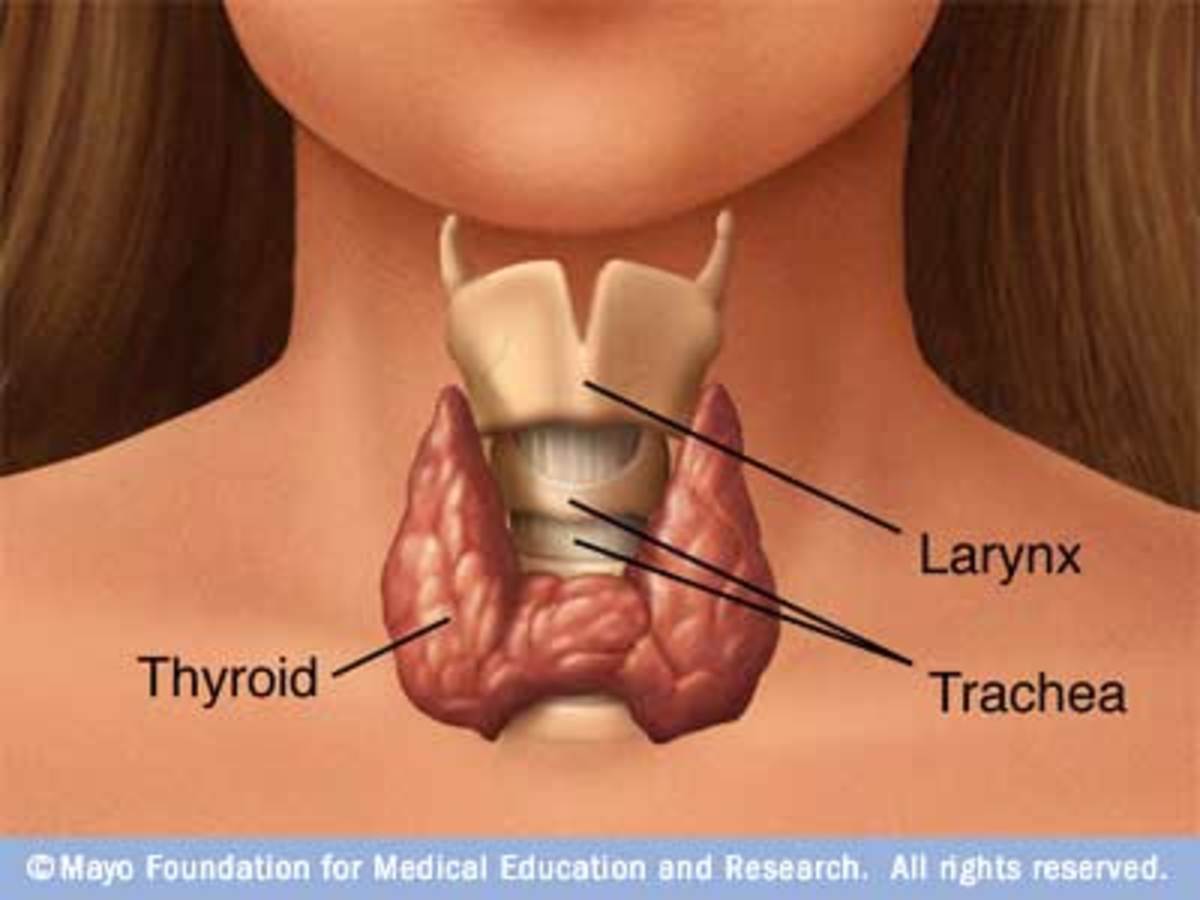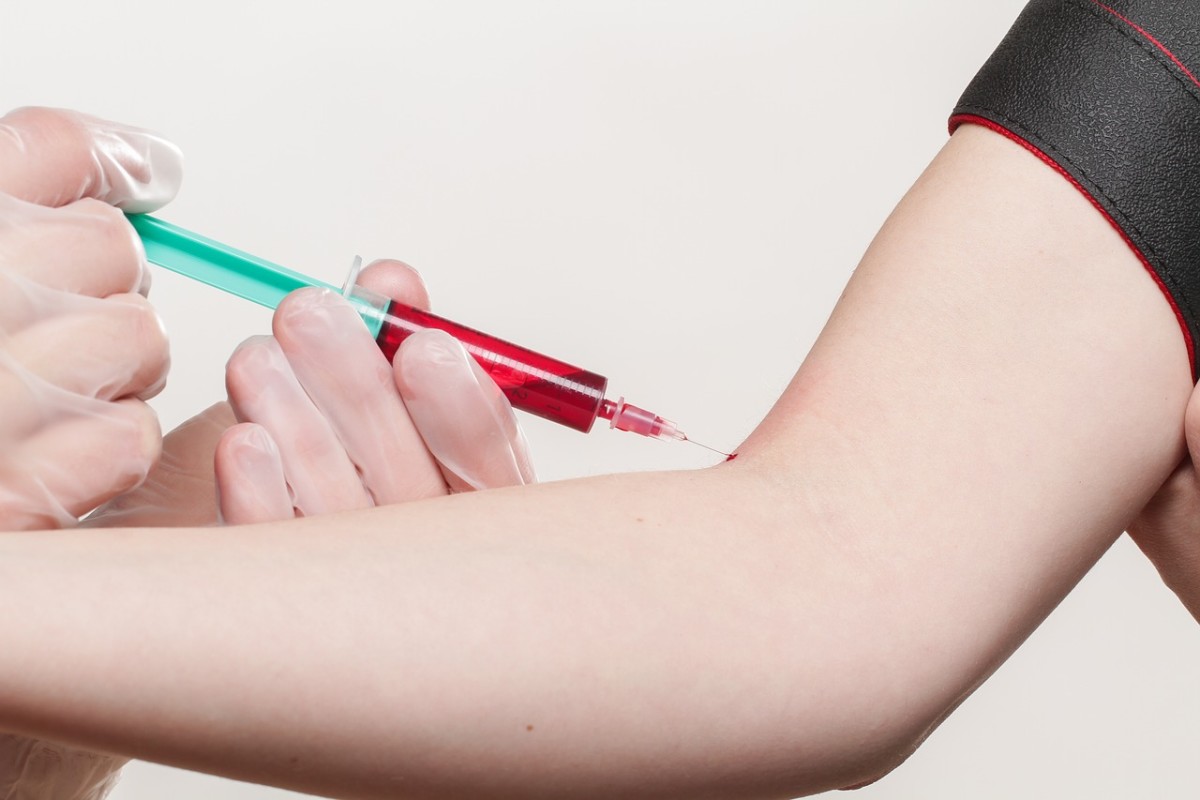Endocrinology-Just Blame It On Your Hormones
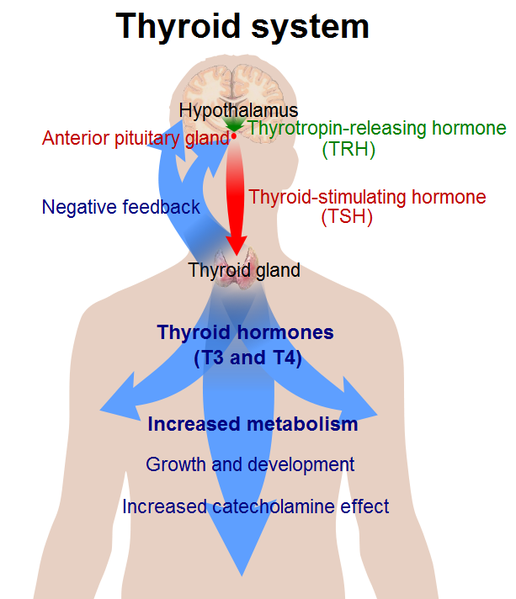
Endocrinology is one of my favorite subdivisions of biology to learn about. I took a course in it during my undergraduate degree, years later after a routine physical my thyroid levels, according to my blood test, came back as abnormal. The nurse practitioner called me and asked how I was feeling. I answered fine and nothing more came of it until a few years went by and not one, not two, but three thyroid goiters were noticed around my thyroid, compensating for my inactive thyroid gland by producing thyroid hormone within them. It lead me to look into Endocrinology again, and it made me realize asking a person the general ‘How do you feel?’ question in regards to an endocrine organ is ridiculously vague. The thyroid and its hormones play a role in so many different mechanisms within the body, often making diagnosis of thyroid dysfunction difficult. In addition many symptoms associated with the thyroid can snowball over time. Fatigue and appetite are two multi-factorial functions the thyroid plays a role in. If one feels increasingly tired overtime, it is less noticeable than all of the sudden. Asking someone specific questions about endocrine organ function would illicit a better response than ‘Fine.’
This leads me to the topic of this article, how we can blame virtually anything going wrong in our bodies on hormones. Endocrinology fascinates me- the different, often paired, hormones and all they control in the human body. Similarities hormones possess include their construction- made in one location and shipped off to another to function, like little soldiers trained and sent off on a mission- and common modes of action. One common mechanism is binding to a receptor on the target cell’s surface and initiating a cascade of changes inside the cell. This is the equivalent of a person standing outside a house, knocking on the door but never entering. The knocking alone has everyone inside scrambling; maybe they weren’t expecting company and are quickly cleaning up. Ultimately this knock on the door is a signal, allowing for a chain reaction to occur within the cell. This one ‘knock’ by the hormone will be amplified in the actions taking place within the cell as the signal is passed on.
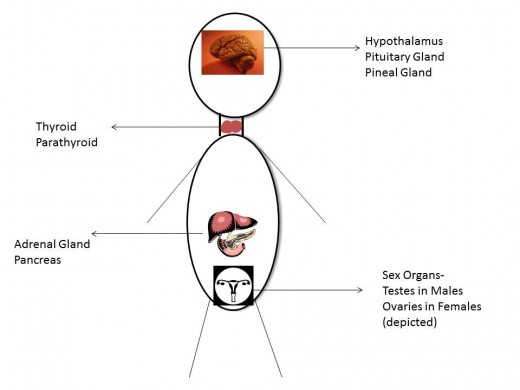
There are approximately 50 known hormones in the human body, with nine primary sites of hormone development. Organs of the endocrine system include, but are not limited, to the hypothalamus, pituitary gland, pineal gland, thyroid, parathyroid gland, adrenal glands, pancreas, and sex organs- the ovaries and testes. The endocrine system is often taught in courses back to back with the nervous system since both are messengers systems of the body. Ultimately when a hormone is made and sent to its target organ, it is delivering a message to the organ letting it know it needs to make a change. Hormones function to allow for growth, differentiation, and release storage forms of glucose for energy use to name just a few. There are additional organs that produce hormones but since their primary functions belong in other systems- such as the thymus, heart, and kidneys- they are not grouped as endocrine organs. We will start at the head, taking a look at each major endocrine organ as we move down the body.
Hormones made by the Anterior Pituitary Gland
MSH=Melanocyte-Stimulating Hormone
| GH= Growth Hormone
|
PRL= Prolactin
| FSH= Follicle-Stimulating Hormone
|
LH=Luteinizing Hormone
| TSH= Thyroid Stimulating Hormone
|
ACTH=Andenocorticotropic Hormone
|
The hypothalamus is the control center of the endocrine system, the connection between the nervous and endocrine systems. It regulates the pituitary gland, a major endocrine organ, which in turn regulates the thyroid, adrenal cortex, and the sex organs. Anatomically the pituitary gland is divided into two regions- anterior and posterior. The posterior pituitary gland makes ADH (Anti-Diuretic Hormone) and oxytocin. While the anterior pituitary gland is responsible for production of GH, PRL, FSH, LH, TSH, ACTH, and MSH. Overall by the nomenclature alone, elaborated on in the table, it is clear the anterior pituitary gland functions in regulating other parts of the endocrine system. A deficiency situation involving one of these stimulating hormones would negatively impact the hormone production at its endocrine site.
The Pineal Gland, a pine cone shaped gland located within the brain, produces melatonin. Melatonin plays a role in metabolism as well as regulating functions associated with light and season change, as well as biorhythms associated with reproduction. External light influences the pineal gland. Since conversion of serotonin to melatonin occurs mainly in the absence of light stimulus, the lowest levels of melatonin occur during the day with peaks in concentration at night. The pineal gland works closely with the hypothalamus and anterior pituitary gland, as it inhibits gonadotropic-releasing hormone (GnRH) production in the hypothalamus which is the necessary signal for the anterior pituitary to secrete LH and FSH- all of this affecting reproduction. Melatonin plays a role in sleep-wake cycles, including jet lag. Current research of melatonin's involvement with thermoregulation, immune function, inhibition of tumor growth, and conception difficulties are underway.
The thyroid hormones deal with development, bioenergetics, and homeostasis. These categories represent a broad list of functions- each involved in many different bodily actions. Homeostasis alone involves blood pressure, heart rate, metabolism, and reproduction. Ultimately there are two sources of thyroid hormone-T3 and T4. Both are iodothyronine, T3 is tri-iodothyronine and while T4 is tetra-iodothyronine, it typically goes by thyroxine. Symptoms associated with thyroid dysfunction include gastrointestinal problems, temperature-regulation issues, heart palpitations, anxiety, fatigue, and fluctuations in weight. Often times you may hear people blame their thyroid on weight gain or on their annoying ability to eat everything in sight and never gain. And the correlation is true, thyroid dysfunction can be the major culprit behind weight issues.
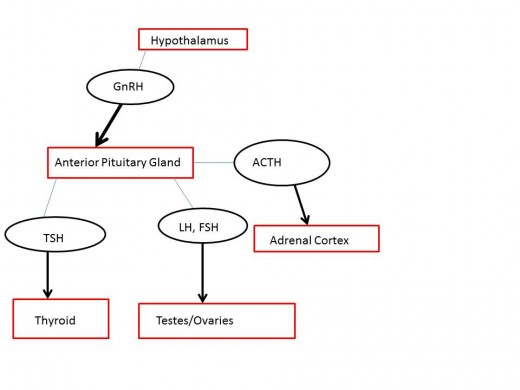
The other hormone produced by the thyroid is calcitonin, which functions in calcium homeostasis. Calcitonin brings up a major theme in the endocrine system - matched sets of hormones that function in opposition of each other. Calcitonin lowers calcium levels in the blood, and its companion hormone, parathyroid hormone (PTH), raises calcium blood levels. As the name implies- PTH is produced by the parathyroid gland. The organ itself, again as the name implies, is close to the thyroid. I eventually opted for surgical removal of my three thyroid goiters which means a total thyroidectomy. Two of my four parathyroid glands were located within my thyroid tissue and thus came out as well. Luckily a person is well enough equip with two of the four parathyroid glands for proper calcium metabolism function. Generally speaking exactly where the two sets (each consists of paired glands) of parathyroid glands are located can be a bit of a mystery, but the vicinity of the thyroid in the neck is vaguely correct. Calcium regulation by both the thyroid and parathyroid has effects on bone density, blood clotting, muscle function, and overall hormone function; as calcium itself plays a role in each of these.
In mentioning antagonistic hormone pairs above, one does not have to look any further than the next endocrine organ, the pancreas which produces insulin and glucagon. This pair of hormones regulate blood glucose; insulin lowers while glucagon raises it. Both are made within specialized cells, Islets of Langerhans, the alpha cell type secretes glucagon while the beta type secretes insulin. Diabetes Mellitus encompasses all types of diabetes where these hormones are in a state of dysfunction, specifically where insulin is deficient while glucagon is in excess. Type I Diabetes or Insulin-Dependent Diabetes requires insulin injections since the patient’s pancreas makes virtually no insulin. People with Type II Diabetes or Non-Insulin-Dependent Diabetes do not require insulin injections but instead manage the disorder with lifestyle-diet and exercise-and in some cases medication. Increased thirst, excessive eating, and frequent urination are outward symptoms of problems with these pancreatic hormones. Again some people may blame Diabetes for their weight, but in the case of Type II, often times a healthy lifestyle and weight lost regimen will ameliorate the disorder.
Next we come to the adrenal glands, whose name tells its general location- ‘ad’ means near, while ‘renal’ indicates the kidney. Note the pluralization indicates there are two of these glands. Like the pituitary gland, each adrenal gland has two separate anatomical regions- the adrenal medulla and the adrenal cortex. The medulla is the interior region and the neurologically area producing adrenaline (AKA epinephrine) and noradrenaline (AKA norepinephrine). These hormones raise the blood glucose level, increase metabolic activities, and constrict certain blood vessels. They act on both the cardiovascular and respiratory systems, increasing blood supply to the heart, brain, and skeletal system. Which subtype of adrenergic receptor the hormone binds to dictates the effect of the hormone. Although the names of these two hormones may indicate they represent another matched set of antagonistic hormones, these two do not oppose each other. Glucocorticoids, mineralocorticoids, and some sex hormones are made in the other region of the adrenal gland, the adrenal cortex. The names of the first two clue us into their major function; glucocorticoids raises glucose blood levels, while the mineralocorticoids regulate mineral metabolism with a role in renal retention of sodium, which also allows retention of water. Cortisol is the major glucocorticoid; it has many diverse actions on most major systems of the body. Hypercortisolism can be the cause behind muscle weakness, poor wound healing, and osteoporosis among others. Going back to the neurologic medulla, hyper-functioning there can be seen in a tumor with increased norepinephrine. Symptoms range from hypertension, anxiety, chest pains and headaches.
Lastly on this tour of the endocrine system are the gonadal steroids which function to regulate growth and development as well as ruling reproductive cycles and sexual behavior. During fetal development the absence or presence of testosterone, müllerian-inhibiting substance (MIS), and dihydrotestosterone (DHT) determine whether an individual will have male or female reproductive components. After development the major sex androgens are testosterone, progesterone, and estrogen. Although the former is associated with males and the latter two are associated with females, these three hormones are made in all adults. Testosterone is the major male androgen, produced by the Leydig cells of the testis; women produce it in the ovaries in very small amounts. Likewise, both females and males produce estrogen, the most plentiful estradiol-17β, and progestin, the most abundant progesterone, produced in the ovaries for women and for men in corresponding organs. Overall, sex hormones allow for growth and development of sexual characteristics in both genders. Progesterone functions largely in various aspects of pregnancy. The overall production chart of these hormones, seen below, show they all start from cholesterol. Progesterone is an early precursor to the others, with testosterone leading to the various estrogens and DHT. With this information it is clear to see how disorders, for example where males have female characteristics or underdevelopment male reproductive components, occur due to incorrect formulation of a given gender’s sex hormones.
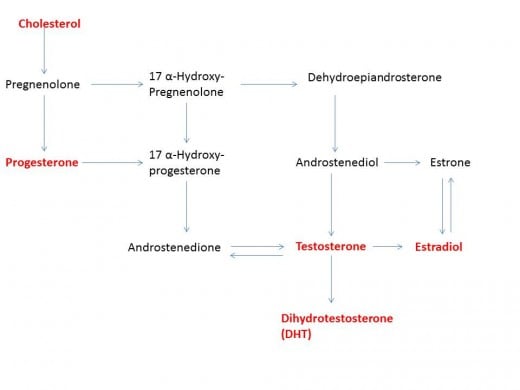
In summary, the major endocrine organs were mentioned, starting at the top of the body with the hypothalamus and ending with the sex organs. This approach illustrates the top down control of the system. For each organ their major hormones were mentioned along with symptoms associated when problems with particular hormones occur. Overall hormones are involved with all major systems of the body- growth and development, energy availability and storage, and response to stress to name a few. It is easy to see how so many symptoms-fatigue, weight gain, headache- can be attributed to a disruption in our hormones. A look into the chemical structures of hormones and how this dictates their means to get around in the body and their mechanism of action can be seen part two. These two articles together serve only as an introduction to endocrinology since this is a vast subject.
Part Two
- Intro to Endocrinology- Part Two
Second part of an introduction to endocrinology. Here the chemical nature of a given hormone is used to predict its mode of action in the body. Also a look at feedback, common pathways used by hormones, and paracrine and autocrine signalling.


